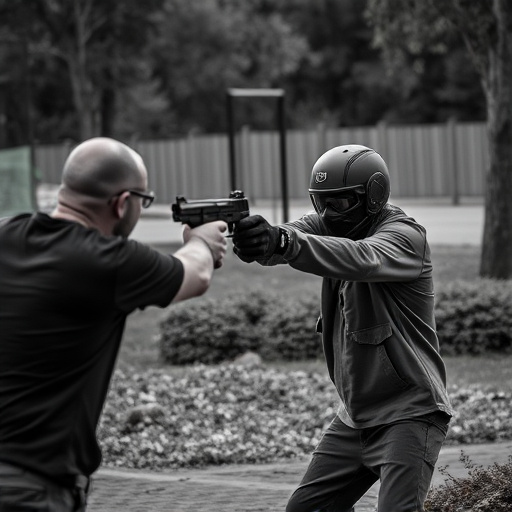In the US, stun gun regulations vary widely among states due to differing public safety concerns, crime rates, and constitutional interpretations. The key issue is balancing responsible ownership with mitigating potential long-term neurological stun effects, which research indicates could include cognitive impairment, neuroinflammation, and chronic neurological conditions. While immediate physical harm is generally addressed, growing awareness of these delayed impacts has led to stricter rules in some states, especially targeting vulnerable populations and sensitive locations like schools and workplaces. Court decisions have been influenced by legal arguments regarding long-term neurological stun effects, with advocacy groups raising concerns about permanent brain damage in vulnerable individuals. Understanding these effects is crucial for shaping future legislative decisions on stun gun restrictions as technology evolves and scientific knowledge expands.
“Unraveling the complex web of stun gun legal restrictions across the US states is crucial for understanding public safety and individual rights. This comprehensive guide, ‘Stun Gun Legal Restrictions by State,’ offers a detailed look at the varying laws governing these non-lethal weapons. From understanding regulatory nuances to exploring the potential long-term neurological impacts, this article delves into the debate surrounding stun guns. We analyze state-by-state regulations, legal arguments, and court decisions, while also predicting future prospects in light of ongoing discussions on public safety and personal defense.”
- Understanding Stun Gun Regulations: A Comprehensive Overview
- Long-Term Neurological Impacts: What the Research Says
- State-by-State Legal Landscape: Exploring the Variability in Laws
- The Debate Around Stun Gun Use: Public Safety vs Individual Rights
- Legal Arguments and Court Decisions Shaping Stun Gun Legality
- Future Prospects: Predicting Changes in Stun Gun Legal Restrictions
Understanding Stun Gun Regulations: A Comprehensive Overview

Understanding Stun Gun Regulations: A Comprehensive Overview
In the United States, stun guns, also known as electronic control devices (ECDs), are subject to varying legal restrictions across different states. This comprehensive overview aims to demystify these regulations, offering a clear path for individuals seeking to understand and comply with local laws regarding stun gun ownership and use. Each state has its own set of rules governing the sale, possession, and application of stun guns, which can range from stringent to relatively lenient. These restrictions often consider factors such as public safety, personal defense needs, and the potential for misuse or abuse of ECDs.
One critical aspect that sets stun guns apart from traditional firearms is their non-lethal nature, particularly in terms of long-term neurological stun effects. While they are designed to incapacitate individuals temporarily through electric shocks, research into their lasting impact on brain function remains limited. As a result, state regulations often reflect a delicate balance between empowering citizens for self-defense and mitigating potential risks associated with stun gun use. Understanding these nuances is essential for responsible stun gun ownership and ensuring compliance with local laws.
Long-Term Neurological Impacts: What the Research Says

The long-term neurological impacts of using stun guns are a growing area of interest for researchers and healthcare professionals. While immediate effects like temporary muscle weakness, disorientation, and memory lapses have been well-documented, studies suggest that repeated exposure to stun gun shocks may lead to more severe, lasting consequences for brain health. Research indicates potential risks such as cognitive impairment, neuroinflammation, and even the initiation of chronic neurological conditions in some users.
Several animal studies have shown that stun gun discharges can cause structural changes in the brain over time, affecting areas responsible for learning, memory, and motor control. Human subjects exposed to repeated shocks may experience difficulties with concentration, decision-making, and balance long after the initial incident. As awareness of these potential risks grows, so does the importance of regulating stun gun use and promoting responsible ownership to mitigate the long-term neurological stun effects.
State-by-State Legal Landscape: Exploring the Variability in Laws

The legal landscape surrounding stun guns varies significantly from state to state in the US, creating a patchwork of regulations that can leave citizens confused and potentially vulnerable. Understanding these laws is crucial for those considering owning or carrying a stun device for self-defense. Each state has its own set of rules governing the possession, use, and sale of stun guns, with some being more restrictive than others. These variations are often driven by public safety concerns, historical trends in crime rates, and differing interpretations of constitutional rights.
One critical aspect that varies across states is the consideration of long-term neurological stun effects. While most laws focus on immediate safety and the potential for physical harm, there’s a growing awareness of the possible delayed impacts of stun gun use. This includes concerns about cognitive function and mental health implications, which are areas where more research is needed to inform legislation. As such, some states have implemented stricter regulations, banning or restricting the use of stun guns entirely in certain circumstances, especially when targeting vulnerable populations or in specific settings like schools or workplaces.
The Debate Around Stun Gun Use: Public Safety vs Individual Rights

The debate surrounding stun guns often revolves around a delicate balance between public safety and individual rights. While advocates argue that stun guns offer a non-lethal means of self-defense, raising awareness about personal safety, critics raise concerns about potential long-term neurological stun effects and the misuse of such devices. This ongoing discussion underscores the need for clear legal restrictions to ensure responsible ownership while safeguarding communities from unforeseen risks associated with stun gun use.
The allure of stun guns as a self-defense mechanism is not without its shadows. Studies exploring the potential long-term neurological stun effects have sparked apprehension among medical professionals and public safety advocates. Even brief exposure to stun gun shocks can lead to temporary disorientation, memory lapses, and in some cases, more severe complications. These findings prompt careful consideration of who should access such devices and under what circumstances, especially as the popularity of stun guns continues to rise across various states.
Legal Arguments and Court Decisions Shaping Stun Gun Legality

Legal Arguments and Court Decisions have played a pivotal role in shaping the legality of stun guns across various states. One key aspect that has garnered significant attention is the potential for long-term neurological stun effects. Advocacy groups have argued that the use of stun guns could lead to permanent brain damage, especially in vulnerable populations such as children and the elderly. These concerns have driven many courts to scrutinize the safety claims made by manufacturers, often resulting in stricter regulations or outright bans on stun gun ownership.
Notably, court decisions have highlighted the need for comprehensive studies on the long-term health implications of stun gun usage. Some states have responded by mandating extensive research and reporting on potential adverse effects before considering further legalization. This cautious approach reflects a growing awareness of the complex interplay between stun gun technology and human physiology, underscoring the importance of evidence-based policymaking in ensuring public safety.
Future Prospects: Predicting Changes in Stun Gun Legal Restrictions

As we move forward, understanding the potential long-term neurological stun effects could significantly influence future legislative decisions regarding stun gun legal restrictions. Research in neurobiology and psychology continues to uncover insights into the lasting impact of even non-lethal force instruments on the human brain. With advancements in technology, stun guns have become more powerful and accessible, leading to concerns about their misuse and unforeseen consequences.
Predicting changes in legal restrictions involves keeping pace with scientific discoveries and societal attitudes. The evolving nature of laws reflects public perception and the balance between individual rights and community safety. As knowledge expands regarding the long-term neurological stun effects, it may prompt a reevaluation of current regulations to ensure they remain both effective and humane. This dynamic landscape demands continuous monitoring and adaptation to better manage the use of stun guns in various states.
The regulation of stun guns varies greatly across states, reflecting a complex balance between public safety and individual rights. While research on long-term neurological stun effects continues to evolve, it’s clear that these devices can cause significant harm. As the debate rages on, future legal prospects may see more uniform guidelines based on emerging scientific evidence, ensuring a safer environment for all. Understanding state-specific laws and staying informed about ongoing court decisions is crucial for navigating this dynamic landscape.
